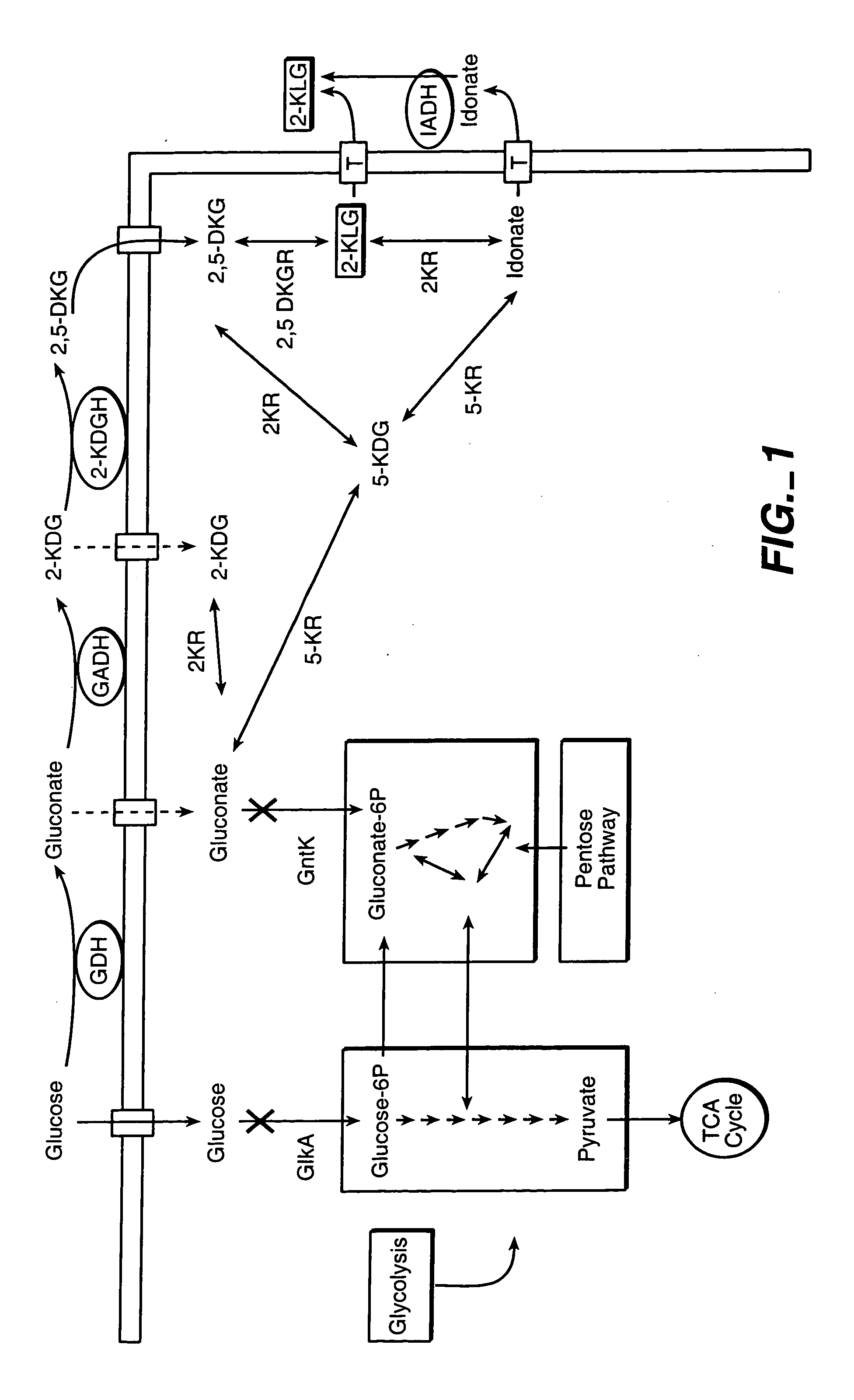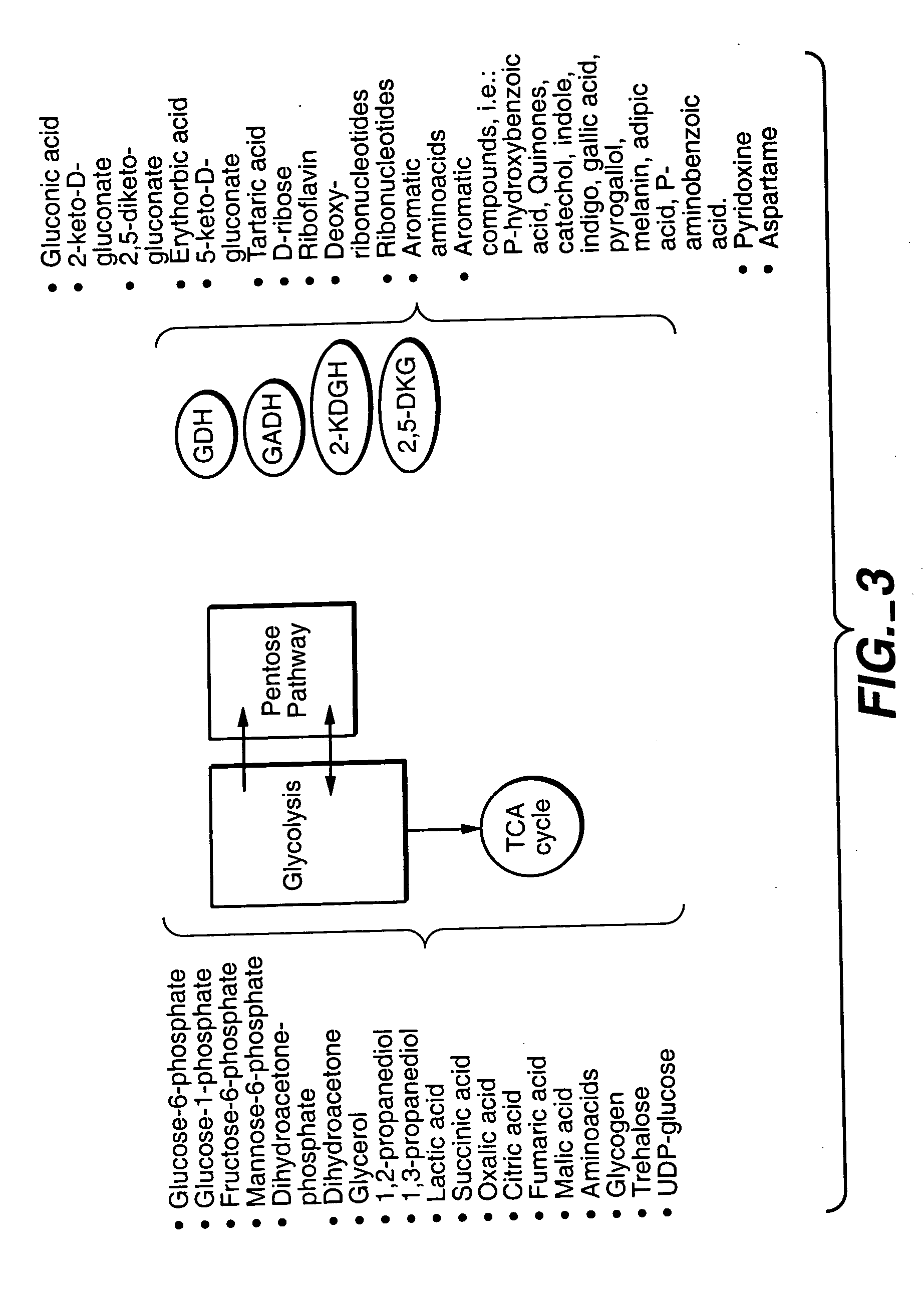Uncoupled productive and catabolic host cell pathways
a catabolic and productive technology, applied in the direction of enzymology, organic chemistry, transferases, etc., can solve the problems of reducing the efficiency of conversion of a carbon source and reducing the efficiency of conversion of a carbon substrate into a desired produ
- Summary
- Abstract
- Description
- Claims
- Application Information
AI Technical Summary
Benefits of technology
Problems solved by technology
Method used
Image
Examples
example 1
Construction of a Genomic Library from P. citrea 139-2a
[0202]P. citrea genomic DNA was prepared using the DNA-Pure™ genomic DNA Isolation Kit (CPG, Lincoln Park, N.J.). 50 micrograms of this DNA was partially digested with the restriction enzyme Sau3A accordingly the manufacturer recommendations (Roche Molecular Biochemicals, Indianapolis, Ind.). The products of the digestion were separated on a 1% agarose gel and the DNA fragments of 3-5 kilobases were purified from the gel using the Qiaquick Gel extraction kit (Qiagen Inc. Valencia, Calif.). The resulting DNA was ligated with BamH1H-linearized plasmid pBK-CMV (Stratagene, La Jolla, Calif.). A library of around 10×× different plasmids was obtained in this way.
example 2
Isolation of the Structural Gene for the Glucokinase Enzyme.
[0203] To select for a plasmid that carries the glucokinase gene from P. citrea, the genomic library (see above) was transformed into a E. coli strain devoid of the glucokinase gene (glkA) and the PTS transport system, strain NF9, glk−, (Flores et al., Nat. Biotech. 14, 620-623). After transformation, the cells were selected for growth on M9 media with glucose as the only carbon source. With this strategy, plasmids able to complement the glk− or pts− mutations were selected.
[0204] After 48 hrs. of incubation at 37° C., many colonies were visible. Several of these colonies were further purified and their plasmids isolated and characterized by restriction analysis. It was found that all the plasmids contained a common DNA fragment.
[0205] After re-transforming these plasmids back into NF9, glk−, all of them allowed growth on M9-glucose media, corroborating that they were able to complement at least one of the mutations pre...
example 3
Inactivation of the Glucokinase Gene by Homologous Recombination.
[0207] The general strategy to inactivate genes by homologous recombination with a a suicide vector has been delineated before (Miller and Mekalanos, J. Bacteriol. 170 (1988) 2575-2583). To inactivate the glk gene from P. citrea by this approach two plasmids were constructed: pMD5 and pMD6.
[0208] To construct pMD5, plasmid pMD4 was digested with the NcoI and SnaB1 restriction enzymes accordingly manufacturer specifications. (Roche Molecular Biochemicals, Indianapolis, Ind.). The cohesive ends generated by these enzymes were blunt-ended with T4 polymerase using standard techniques. This DNA was ligated with a loxP-Cat-loxP cassette isolated from pLoxCat2 as a SpeI-EcoRV DNA fragment. (Palmeros et al., Gene (2000) 247, 255-264.). This cassette codes for Chloramphenicol resistance. The ligation mixture was transformed into TOP10 competent cell (Invitrogen, Carlsbard Calif.). selecting for growth on Chloramphenicol 10 m...
PUM
| Property | Measurement | Unit |
|---|---|---|
| pH | aaaaa | aaaaa |
| pH | aaaaa | aaaaa |
| pH | aaaaa | aaaaa |
Abstract
Description
Claims
Application Information
 Login to View More
Login to View More - R&D
- Intellectual Property
- Life Sciences
- Materials
- Tech Scout
- Unparalleled Data Quality
- Higher Quality Content
- 60% Fewer Hallucinations
Browse by: Latest US Patents, China's latest patents, Technical Efficacy Thesaurus, Application Domain, Technology Topic, Popular Technical Reports.
© 2025 PatSnap. All rights reserved.Legal|Privacy policy|Modern Slavery Act Transparency Statement|Sitemap|About US| Contact US: help@patsnap.com



